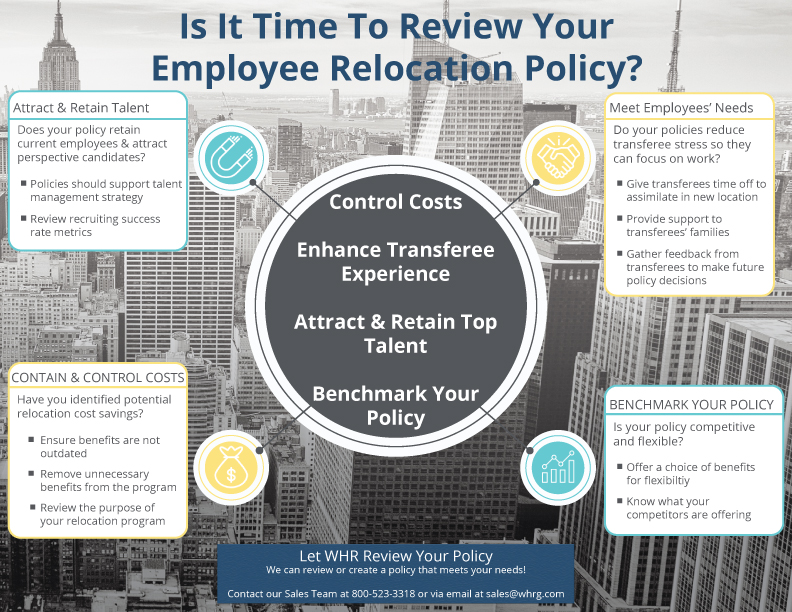以下例子来自WHR Global为客户进行的政策审查。这些例子说明了定期审查搬迁政策的重要性。
A.控制企业成本,停止为不必要的福利买单
确保您为调职人员和组织需求分配了适当的金额。同样重要的是,不要为不必要或过时的福利买单。
- 示例 #1
我们审查过一家公司的政策,该公司向每位调职人员提供标准的 5,000 至 10,000 美元搬迁一次性补助金,以帮助他们支付任何额外费用。除了 5,000 至 10,000 美元的一次性津贴外,他们还向高管人员发放相当于 6 周工资的一次性津贴。由于一些高管的工资很高,这笔津贴有时相当于每位高管 5 万美元!经过审查,我们建议公司减少对高管的这种做法。公司节省了数十万美元。 - 示例 #2
某客户在员工搬迁到成本较高地区时支付生活费差额。他们支付了 3-4 年,而且还提供了一大笔一次性福利。我们建议将生活费的最低限额设定为 5%,这样他们就不必为调往生活费略高地区的员工支付生活费。客户因此节省了数百万美元。 - 示例 #3
另一位客户正在向愿意异地任职的在职员工发放非晋升奖金。这些奖金相当于员工工资的 5%。由于这种做法并不常见,我们建议他们取消异地调动政策中的这一规定,这样既节省了大量成本,又不会降低计划的价值。 - 示例 #4
我们的一位客户正在支付贷款发放费。有些贷款机构甚至不收取这笔费用,但如果他们知道客户会支付这笔费用,他们还是会收取这笔费用。客户意识到这一点后,除非必要,否则就不再支付这笔费用了。
B.满足员工需求
您的搬迁政策必须满足调职人员的需求。这有助于减轻调职人员的压力,使员工能够专注于新工作地点的工作。给予调职人员休息时间以适应新的工作地点、为调职人员的家人提供支持,以及收集调职后的反馈意见以制定未来的政策决策,这些都有助于满足调职人员的需求。
- 示例 #1
我们的一位客户为所有国际搬迁提供一次性补贴。通过收集搬迁后的调查反馈,我们发现调职人员试图自己协调国际家居用品(HHG)的运输,而没有花完一次性付款,希望能保留一些钱。调查反馈还显示,让员工有这样的选择权会给他们增加更多的压力,而且会延长搬迁过程。从根本上说,调职人员都在试图自己完成这一切,同时还要节省开支。客户考虑了所有关键福利,认为一次性总付的方式行不通。他们将一次性付款改为核心弹性福利。这意味着客户将支付 HHG 运输、目的地服务提供商和临时住房的费用,但他们仍然给调职人员一笔一次性总付的金额,由员工自行决定使用。这不仅有助于减轻调职人员的压力,还有助于控制业务成本。
- 示例 #2
一位客户没有为在欧洲内部搬迁的配偶/伴侣和家人提供目的地服务。他们认为,如果调职者/家庭从俄罗斯迁往英国等地,就不需要目的地服务。通过搬迁后的调查反馈,确定配偶/伴侣需要职业援助、语言培训和帮助子女找学校。员工有办公室工作人员帮助他们融入新的工作地点,但调职人员的伴侣却在新的语言环境中苦苦挣扎,甚至在寻找杂货店等生活必需品时也很吃力。认识到整个家庭而不仅仅是调职者的需求,对于确保成功搬迁和同化至关重要。
C.吸引/留住人才,再加上以竞争对手为基准制定政策
希望您的异地安置政策已经成为您的整体奖励和人才管理战略的一部分。正确的政策将帮助贵公司留住现有员工并吸引有潜力的候选人。薄弱的异地安置政策可能会对招聘成功率产生负面影响。
将您的政策与其他公司的政策进行比较,有助于您在人才争夺战中保持竞争力。请确保您的政策提供了多种选择,因为异地安置政策是与工作机会捆绑在一起的。如果不以竞争对手为基准,您就不知道自己的政策是否合理。与其他人提供的服务相比,它们是否有差距?例如,如果您招聘的是高级管理人员,而这些人才非常特殊且不易获得,那么您就需要确保您的薪资、福利和异地安置政策具有竞争力。
同时,设定基准可以确保在竞争对手都没有这样做的情况下,你不会让出太多。将您的政策与其他政策进行比较,可以表明您与行业保持一致。同样重要的是,不仅要关注自己所在的行业,还要关注与自己争夺人才的其他行业。
- 示例 #1
想象一下,因为你的迁居政策中缺少竞争对手所包含的福利,而失去了一位潜在的候选人。例如,如果您的候选人是一位希望获得全额买断的高管,但您的政策只包括 HHG 搬迁和一次性付款,那么您就不得不来回与上级和候选人进行谈判。这会浪费很多时间。在此期间,应聘者可能会收到一份更好的工作邀请,包括更多的搬迁福利。异地安置政策可能是应聘者决定是否接受一份工作的一个因素。如果您已经将自己的政策与竞争对手进行了比较,您就会知道他们的政策包括哪些内容。
- 示例 #2
某客户的人才招聘团队反馈说,很难填补某些职位。在审查了他们的政策并与竞争对手进行比较后,我们发现他们的竞争对手提供的异地福利要丰富得多。因此,该公司决定扩大可享受全额异地福利的职位范围。
D.您应该多久审查一次您的政策?
WHR 建议您每年或最长每两年审查一次员工搬迁政策。这并不一定是一次大修,但它是一个让你停下来看看员工反馈的机会。此外,您还应确认公司文化、驱动原则、核心价值观、人才战略、行业和竞争对手的任何变化。在审查过程中,您应确保您的政策与所有这些方面以及您的主要利益相关者(人才招聘团队、招聘团队、人力资源业务合作伙伴)保持一致。


